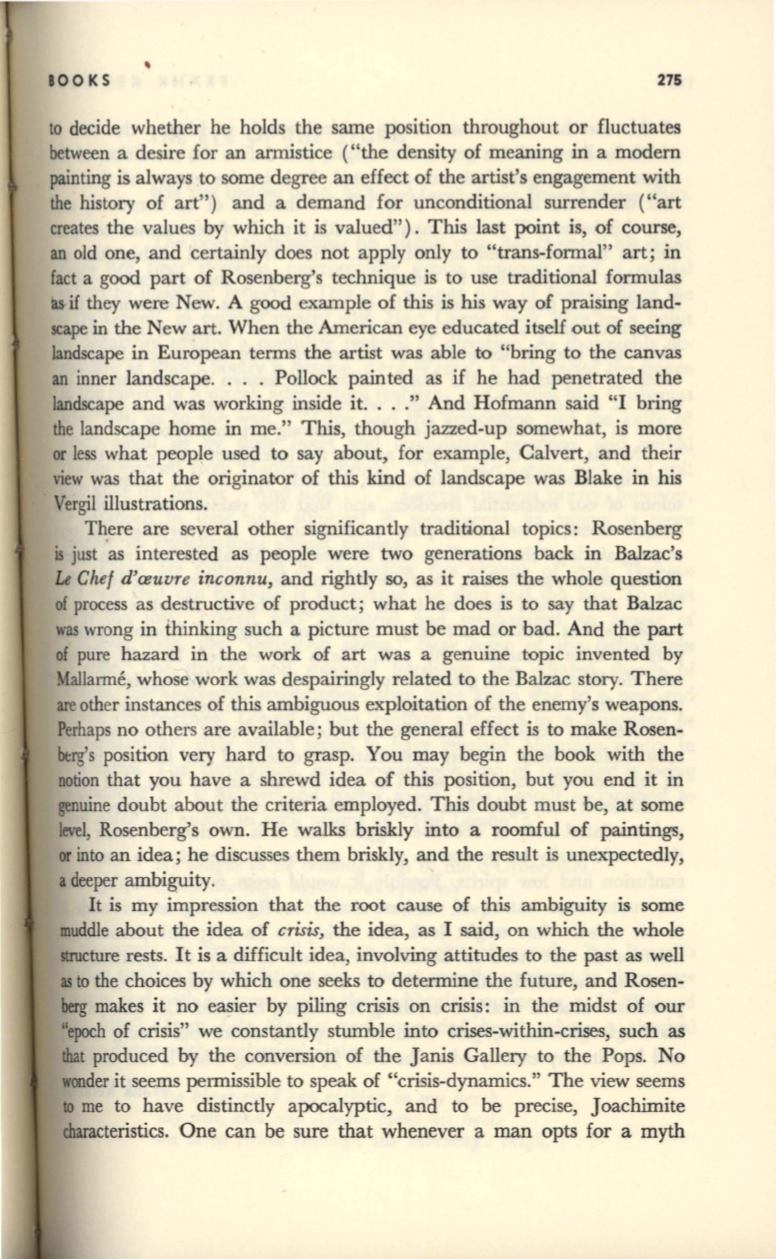
lOOKS
275
to
decide whether he holds the same posItIOn throughout or fluctuates
between a desire for an annistice ("the density of meaning in a modern
painting is always to some degree an effect of the artist's engagement with
the history of art") and a demand for unconditional surrender ("art
creates the values by which it is valued") . This last point is, of course,
an
old one, and certainly does not apply only to "trans-formal" art; in
fact a good part of Rosenberg's technique is to use traditional formulas
U if they were New. A good example of this is his way of praising land–
scape in the New art. When the American eye educated itself out of seeing
landscape in European terms the artist was able to "bring to the canvas
an
inner landscape.... Pollock painted as if he had penetrated the
landscape and was working inside it. ..." And Hofmann said "I bring
the landscape home in me." This, though jazzed-up somewhat, is more
or less what people used to say about, for example, Calvert, and their
view was that the originator of this kind of landscape was Blake in his
Vergil illustrations.
Th.ere are several other significantly traditional topics: Rosenberg
is
just as interested as people were two generations back in Balzac's
I.e
Chef d'reuvre inconnu,
and rightly so, as it raises the whole question
of
process as destructive of product; what he does is to say that Balzac
was
wrong in thinking such a picture must be mad or bad. And the part
of
pure hazard in the work of art was a genuine topic invented by
Mallarme, whose work was despairingly related to the Balzac story. There
are other instances of this ambiguous exploitation of the enemy's weapons.
Perhaps no others are available; but the general effect is to make Rosen–
btrg's position very hard to grasp. You may begin the book with the
notion that you have a shrewd idea of this position, but you end it in
senuine doubt about the criteria employed. This doubt must be, at some
level, Rosenberg'S own. He walks briskly into a roomful of paintings,
or into an idea; he discusses them briskly, and the result is unexpectedly,
I
deeper ambiguity.
It is my impression that the root cause of this ambiguity is some
muddle about the idea of
crisis,
the idea, as 1 said, on which the whole
IlrUcture rests. It is a difficult idea, involving attitudes to the past as well
.. to
the choices by which one seeks to determine the future, and Rosen–
berg
makes it no easier by piling crisis on crisis: in the midst of our
"epoch of crisis" we constantly stumble into crises-within-crises, such as
lbat
produced
by
the conversion of the Janis Gallery to the Pops. No
wonder it seems permissible to speak of "crisis-dynamics." The view seems
m
me to have distinctly apocalyptic, and to be precise, Joachimite
characteristics. One can be sure that whenever a man opts for a myth


